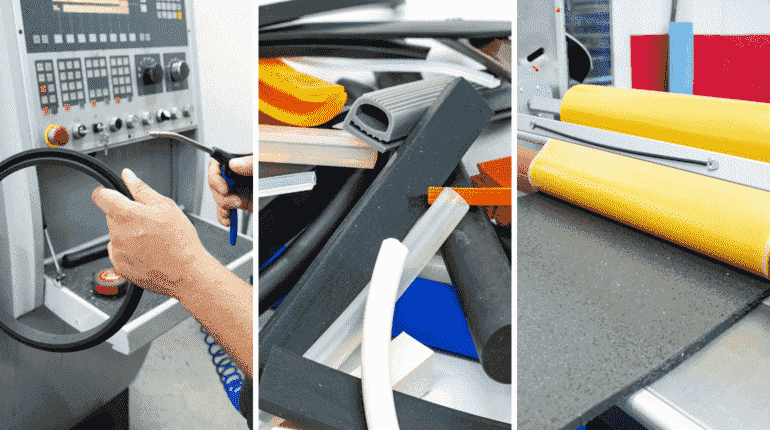So, what are gaskets?
A gasket is a mechanical seal that fills the space between two or more joining surfaces. Its primary purpose is to prevent leakage from or into the mating object under compression. Gaskets maintain seals under various operating conditions (like temperature, pressure, oil, gas, etc.).
The correct gasket material must be used according to the application’s needs. It is recommended that the gasket should be made of material that could be deformed to fill the space. Some gaskets may require a sealant to be applied to the mating surface for proper functioning.
The different types of gaskets
Gaskets are categorized based on the material they are manufactured from. Their purpose is also different. For example, asbestos is hazardous, so we can’t use asbestos gaskets in the food industry.
Sheet gaskets
These gaskets are produced by punching the required shape out of a flat and thin sheet made of various materials. Sheet gaskets are fast and cheap to produce. There are a variety of materials from which these sheet gaskets could be produced. Some of these are fibrous material, graphite, asbestos, mineral, carbon or synthetic rubber (EPDM, nitrile, and neoprene), and natural rubber. Read more on gummilist.
Solid material gaskets
Solid material gaskets can withstand much higher temperatures and pressures. The downside is that a solid metal gasket must be significantly compressed to prevent leakage. The choice of material for making solid gaskets is more complex than sheet gaskets because metals are prone to contamination and oxidation.
Spiral-wound gaskets
Spiral-wound gaskets are made by winding a metal strip with a softer filler. Metal strips are usually made of stainless steel, and the filler is made of graphite or PTFE. The materials are wound from the opposite side, giving alternating layers of metal and filler. Metal is used for structural strength, and filler material acts as the sealant.
The inner and outer ring is the third component of a spiral wound gasket. Spiral wound gaskets also come without an inner ring. These gaskets are reliable to withstand greater pressure and temperature in the application.
Constant seating stress gaskets
When flanges are bolted together, the resulting load on the gasket material is uneven. The outer edge of each flange bends inwards towards the pipe centerline, putting more load on the other edge of the gasket. As a result, the gasket material compresses more at the outside diameter than the inside. This load on a gasket is known as the gasket seating stress.
Gaskets are available to even out this stress and solve the problem of seating stress. These are constant seating stress gaskets. In these gaskets, an incompressible metal (usually stainless steel) is placed between the flanges. The benefit of using metal is that it creates a minimum gap on either side of the annulus. Then, it is filled with compressible gasket material, which could be Neoprene, PTFE, or graphite.
The constant seating stress gasket is immune to common gasket failures, such as creep relaxation, high system vibration, and system thermal cycles.
Double jacketed gaskets
This gasket also combines Filler and metallic materials. A tube-shaped C is made of metal, and another piece, also shaped C, works as a shell. Then, the Filler is pumped between the shell and the piece. At the contact of the tips, the compressed gasket has a large amount of metal. These tips bear the burden of sealing the flanges.
Kammprofile gaskets
Kammprofile gaskets have two names: camprofile (because of its design resembling the camshaft of a combustion engine) and groove metal gasket. Camprofile gaskets have a solid metal core with concentric grooves. Graphite or PTFE is a filler material layered on this grooved metal ring.
Kammprofile gaskets have found their use in heat exchangers and the oil and gas industry. These gaskets are costlier but much more reliable than double-jacketed gaskets.
Fishbone gaskets
Fishbone gaskets are fully CNC machined and don’t unwind in storage or plants. They could replace camprofile and spiral wound gaskets because they are much more reliable and outperform all other gaskets.
Flange gaskets
Gaskets that are made to fit between two sections of pipe for various purposes (sealing or leakage) are called flange gaskets. Flange gaskets come in various sizes and shapes in the market, categorized by their inside and outside diameter. The gaskets for flanges can be categorized into four major types
- Sheet gaskets
- Corrugated metal gaskets
- Ring gaskets
- Spiral wound gaskets
Soft cut gaskets
Soft gasket is a term used when referring to a gasket cut from soft sheet material. It can quickly adapt to surface irregularities despite low bolt load. The material from which the soft gasket is made could be rubber, PTFE, graphite, and compressed asbestos & non-asbestos sheet. Soft gaskets could be used in pipe flanges, heat exchangers, compressors, and bonnet valves.
Ring-type joint gaskets (RTJ gaskets)
The ring-type joint RTJ gasket is a forged ring that fits into the mechanical groove of an RTJ flange. They are octagonal or oval-shaped in cross-section. RTJ gaskets are mainly used for high-pressure and high-temperature applications. It is widely used in the refinery, petrochemical, oil field, and drilling industry. RTJ gaskets are not recommended for reuse because these gaskets have poor maintenance properties.
Types of RTJ gaskets:
- R type
- RX type
- BX type
Corrugated metal gaskets
A corrugated metal gasket is also a combination of metal and filler, but the metal is corrugated (parallel grooves). The core could be made from carbon steel, stainless steel, or other high-temperature materials. The Filler is typically graphite, PTFE, or any other rubber material.
Corrugated metal gaskets have found applications in industry. They can be used in heat exchanger flanges but are not recommended for pipe flanges.
Corrugated metal gasket available in three shapes:
- Circular
- Poval
- Rectangular
What are gasket usage areas?
Sealing
The gasket’s primary purpose is to seal against the leak or ingress of liquids. You must consider the type of rubber from which the gasket is manufactured. A suitable rubber must be used for the right liquid. Specific rubber offers better leakage resistance to chemicals. For example, gaskets made of nitrile are suitable for oil, fuel, and solvents. Neoprene gaskets and EPDM gaskets are best suited for the pipeline industry.
Gasketing for outdoor weather conditions is referred to as environmental gasketing. Outdoor weather gaskets are UV, heat, and freeze-resistant. Their primary function is to seal out rain and protect against UV and high temperatures.
Anti vibration
Silicone, foam, nitrile spine, and urethane rubber gaskets can reduce vibration. These vibration-attenuating gaskets are especially useful in HVAC systems, machinery mountings, pipe supports, structural bearings, and industrial machinery. Anti-vibration pads or flooring are also available to reduce vibration in outdoor environments.
Which gasket should i choose
Gasket should be judged on these three parameters before selecting the given application:
- Gasket material should be compatible with the fluid
- The gasket must withstand the pressure and temperature of the system
- How long will the gasket last?
Choosing a proper gasket for the application is crucial; otherwise, the damage would be much higher. Gaskets must have the properties listed below:
- The impermeability gasket must not be porous to the fluid being sealed; otherwise, there wouldn’t be any benefit to using the seal.
- Compressibility – the gasket should compress into the irregularities on the flange to create the seal.
- Stress relaxation (creep resistance) – When the load and temperature are raised, the gasket should not show significant flow (creep).
- Resilience—Flanges move slightly relative to each other under pressure and temperature. The gaskets should compensate for such movements; otherwise, leakage could happen.
- Chemical resistance—Gaskets should be inert to the chemical processes happening in the medium. They should not contaminate the whole process.
- Temperature resistance – The gaskets should withstand the temperature and pressure effect.
- Anti-stick – The gasket should be easily removable.
- Anti-corrosion – the gaskets must not cause corrosion.
Reason for failure of gasket seals
There are various reasons for the failure of gaskets. Some are mentioned below:
- Unevenly distributed pressing force
- Stress relaxation and torque loss
- Irregular surface
- Metal reinforcement gasket
- Damaged flanges
- Abnormal combustion
- Abrasion
- Vibration
- Detonation
Our conclusion
Gaskets play an essential role in the automotive sector, but also in various other industrial sectors and in consumer products. Different gaskets are available in the market for specific usage and purposes. One should select the gasket according to one’s needs and specifications. So, various factors must be considered while choosing the gaskets for the specific needs and purposes listed above. Good luck!






